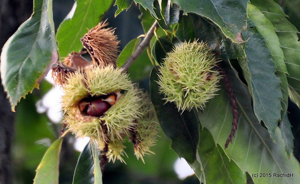After the American chestnut was essentially wiped out by a fungus and other diseases, researchers have created a genetically engineered (GE) chestnut that they claim is resistant to the fungus in question. They hope to release this GE tree into the wild to restore “native” chestnut populations to help the forests, wildlife, and local economies that utilized seasonal nut harvests for sale and food.
 |
Unlike the familiar crops genetically modified to survive the overuse of pesticides, such as Roundup Ready corn, this work is intended to restore a lost species. But concerns abound about a GE tree being released into the wild. First, chestnut trees can live up to 200 years and there is no way to test the environmental effects of GE trees on that kind of time scale. Releasing the tree into the wild will make it very difficult to control if there are negative effects, and there is a high likelihood that the offending fungus may mutate to overcome genetically engineered resistance.
Traditional breeding also works to help plants be resistant to diseases like the fungus that plague the chestnut tree. The American Chestnut Foundation is already working on selective breeding of chestnut trees for the same fungus the GE tree has been developed for. Though slower, these traditional breeding techniques offer consistent results and do not pose the same risks inherent in splicing together genes from dissimilar species.
Some experts wonder whether this apparently well-intentioned GE creation is a public relations stunt to sway public opinion of GMOs.
The GE American Chestnut – Restoration of a Beloved Species or Trojan Horse for Tree Biotechnology?
Independent Science News
by by Rachel Smolker, Ph.D. (Biofuelwatch) and Anne Petermann (Global Justice Ecology Project)
About a century ago the American chestnut tree was attacked by the introduced fungal pathogen (Cryphonectria parasitica). This fungus drove the chestnut to functional extinction. Now, scientists at the State University of New York College of Environmental Science and Forestry (SUNY ESF) claim to have created, through biotechnology, a resistant American chestnut variety. They aim to petition the required regulatory agencies (USDA, FDA, EPA) for deregulation of their genetically engineered chestnut in the near future, with the stated goal of “restoring” the species to nature.
If it is deregulated, the GE chestnut would be the first GE forest tree species to be planted out in forests with the deliberate intention of spreading freely. Monitoring or reversing their spread, once released, would likely be impossible. Performing valid risk assessments of the potential impacts of GE American chestnut on forests, wildlife, water, soils, pollinators or people, is hampered by our lack of knowledge about both the ecology of the American chestnut and forest ecosystems. Furthermore, since American chestnuts can live for more than 200 years, risk factors may change over the tree’s lifetime in unpredictable ways.
Critically, the choices we make about the GE American chestnut will set a precedent for the future use of biotechnology on other forest tree species and even more broadly, on the use of biotechnology, including new technologies such as gene editing, gene drives etc. as “tools for conservation”.

